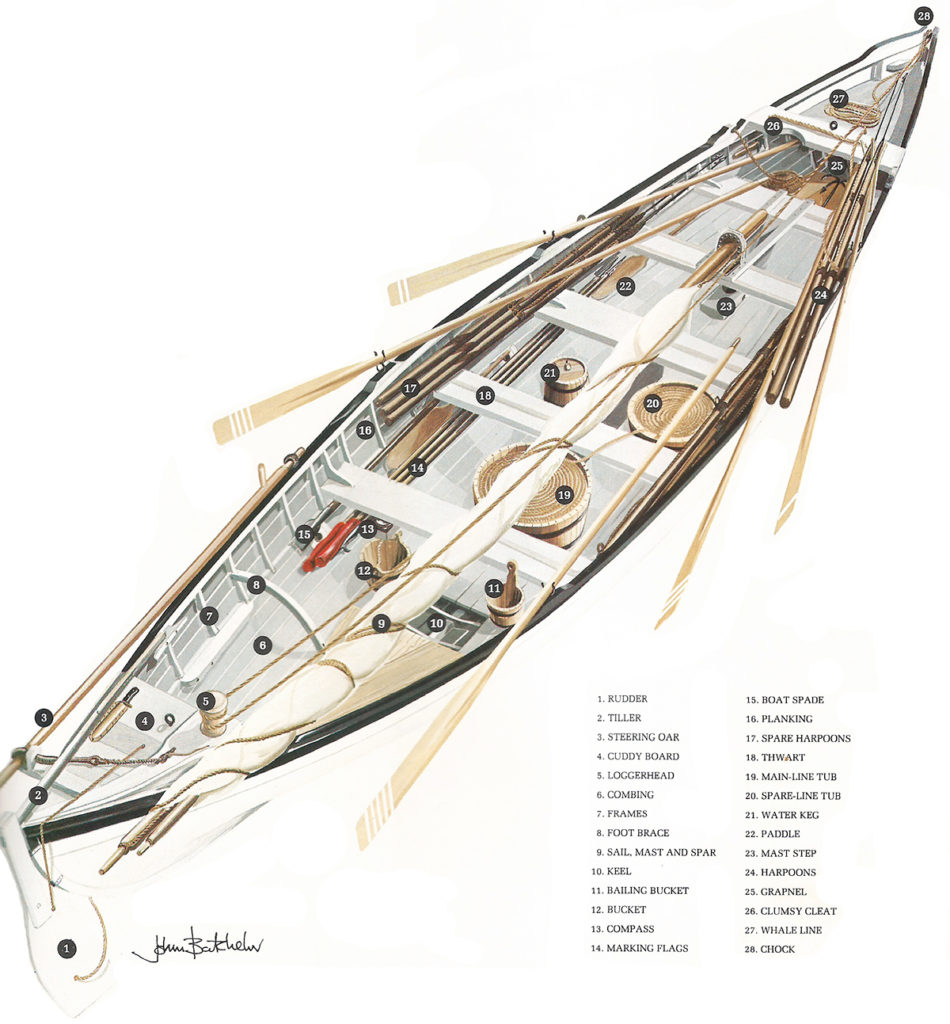The Whaleboat
- At September 21, 2021
- By Great Quail
- In Call of Cthulhu
 0
0
Gayer sallies, more merry mirth, better jokes, and brighter repartees, you never heard over your mahogany, than you will hear over the half-inch white cedar of the whale-boat, when thus hung in hangman’s nooses; and, like the six burghers of Calais before King Edward, the six men composing the crew pull into the jaws of death, with a halter around every neck…
—Herman Melville, “Moby-Dick,” Chapter 60
Whaleboat
A whaleboat is a light but sturdy boat, seating six men and holding an impressive amount of equipment. Usually about 28’ long and 6’ wide at the waist, a whaleboat is pointed at both ends to facilitate rapid retreat. The boat is “clinker-built,” meaning the hull-planks overlap each other. Also known as “lapstrake,” this design increases the strength of the whaleboat, but makes it somewhat noisy in the water. The boat is reinforced by horizontal thwarts, and the bow and stern feature small, triangular decks called “cuddy boards.” The stern cuddy board is usually mounted atop the gunwales, but the bow cuddy board—also called the “box”—is sunk below the gunwales. Just behind this is the harpooneer’s thigh-board. An indentation carved into the board allows the harpooneer to brace his thigh when darting the iron; this is called the “clumsy cleat,” and is often padded with rope. The Quiddity’s whaleboats are white, with the bow and stern painted bright red to make them easier to see at a distance.
Maneuverability
A whaleboat is known for its maneuverability. It can just as easily be rowed backwards as forwards, and can turn within its own length, essentially rotating on the water. It carries five rowing oars and a 20’ steering oar at the stern. There’s also a collection of smaller paddles for fine maneuvering, and a stowable mast and sail. While rarely used during a hunt, the lugsail may be set to take advantage of a fair wind, with the rudder providing steering.
Equipment
A fully-stocked whaleboat contains over a thousand pounds of equipment. Aside from the oars and rigging, the boat carries five harpoons and four lances; a small arsenal of hatchets, knives, and spades; standard boating equipment including compass, bailing piggin, foghorn, and anchor; and specialized whaling equipment such as buoys, waifs, and “drogues”—wooden floats which are attached to the whaleline to exhaust the whale. A water keg, or “breaker” in the center of the boat contains fresh drinking water. A waterproof lantern keg holds an oil lantern, flint & steel, a tinderbox, and a box of candles. Most crews also include tobacco, pipes, and hardtack to sustain them on extended forays.
The Whaleline
A whaleboat wouldn’t be a whaleboat without the all-important whaleline. A hemp rope about two-thirds of an inch thick, the whaleline is coiled in two separate tubs, each holding 150 fathoms of line (900 feet). The leading end emerges from the aft tub and is wrapped around the loggerhead, a thick spindle fixed to the stern. The men control the drag by changing the number of coils around the loggerhead. From here, the line travels down the center of the boat to the bow, where it passes under the “kicking strap,” a length of rope stretched across the thigh-board. The kicking strap limits the horizontal play of the line, which then passes through the bow “chocks” over a wooden roller or pin. After leaving the chocks, the line is looped back into the front of the boat and coiled on the box. This length of “boxline” is attached to two harpoons, each resting in the “crotch,” a Y-shaped brace on the starboard gunwale. The tail end of the line is left free in the tub—if a whale runs out the line, better to let it vanish into the sea than tear the boat apart! However, if another boat is nearby, it’s customary to splice the line to their supply and thereby double the length.
Safety
A ship being dragged by a whale has no need for oars. To keep them free from the whaleline, the oars are “peaked” by fitting their handles into round slots located at the bottom of the boat—you can see one on the diagram above, near #15. This keeps the oars safely elevated above the water. It also forms a wooden valley that cradles the whaleline down the center of the boat. The paddle faces are turned parallel to the water to make them more streamlined.
A live whaleline is self-evidently dangerous, and touching it without leather “nippers” inflicts 1 HP damage. The crew is responsible for pouring water over the coils and the loggerhead, otherwise the running rope may smolder and catch fire. Although the bailing piggin is designed for this purpose, most whalemen use their trusty hats. If a live whaleline slips from the chocks and tears through the kicking strap, it may run down the gunwales and injure the crew. A “thumb cleat” mounted on either side the thigh-board is designed to catch a loose line and prevent this catastrophe!
Sources and Notes
Much thanks to the late John Henry Batchelor, whose wonderful diagram of a whaleboat has been borrowed from A.B.C. Whipple’s woefully out-of-print The Whalers (Time-Life 1979). The kicking strap and larboard thumb cleat would be near #26, the clumsy-cleat, which itself is part of the thigh-board. The nineteenth-century engraving at the top of the page is by J.W. Evans, and is based on an illustration by New Bedford whaleman and photographer Isiah West Taber. To see a whaleboat in action, check out the 1922 silent film, Down to the Sea in Ships. While clearly playing to the sentiments of an early twentieth-century audience, the film depicts an actual whale hunt launched from the real-life Charles W. Morgan.
White Leviathan > The Quiddity and Whaling
[Back to Whaling Tools | White Leviathan TOC | Forward to Hunting Whales]
[PDF: Boat Crew Worksheet]
Author: A. Buell Ruch
Last Modified: 3 October 2021
Email: quail (at) shipwrecklibrary (dot) com
White Leviathan PDF: [TBD]


